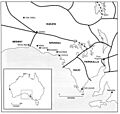Barngarla people facts for kids
The Barngarla people are an Aboriginal group from the areas around Port Lincoln, Whyalla, and Port Augusta in South Australia. They are the traditional owners of a large part of the Eyre Peninsula.
Contents
Barngarla Language
The Barngarla language was once widely spoken, but sadly, it stopped being used in the 1960s.
In 2011, a linguist named Ghil'ad Zuckermann contacted the Barngarla community. He suggested a project to bring their language back to life. The community was very excited about this idea! Workshops began in 2012 in Port Lincoln, Whyalla, and Port Augusta. The project uses old documents, some as old as 170 years, to help teach the language again.
Traditional Lands
The Barngarla people traditionally lived on a large area of land. This land covered about 17,500 square miles (45,000 square kilometers). It stretched around the eastern side of Lake Torrens, going south from Edeowie and west of Hookina and Port Augusta. Their land also reached places like Island Lagoon, Yardea, Woorakimba, Hesso, Yudnapinna, and the Gawler Ranges. To the south, their territory included Kimba, Darke Peak, Cleve, and Franklin Harbour.
How Barngarla Society Was Organised
The Barngarla people had different groups within their society. There were two main divisions:
- The Wartabanggala lived in the northern parts, from north of Port Augusta up to Ogden Hill and near Quorn and Beltana.
- The Malkaripangala lived in the southern areas, along the western side of the Spencer Gulf.
An early missionary named C. W. Schürmann noted in 1844 that the Barngarla were divided into two main classes, called Mattiri and Karraru. These divisions helped organise marriages and family groups within the community.
Barngarla Culture
One special practice in Barngarla culture was "singing to the sharks." This unique ritual ended in the 1960s when the last person who knew how to perform it passed away.
During this ritual, men would stand on the cliffs of bays along the Eyre Peninsula and sing. While they sang, women would dance on the beach. The goal was to encourage sharks and dolphins to help herd large groups of fish closer to the shore. This made it easier for fishers in the shallow water to catch them.
History and Contact
Even before British settlers arrived, the Barngarla faced challenges. The Kokatha people were moving south, which pushed the Barngarla away from their northern borders. This also meant they lost access to certain types of wood needed for making spears. Because of this, they had to travel as far as Tumby Bay to find the special "whipstick mallee ash" wood.
Native Title for Barngarla People
Native title is a legal recognition that Aboriginal and Torres Strait Islander people have rights and interests in land and waters based on their traditional laws and customs.
On January 22, 2015, the Barngarla people were granted native title over a large part of the Eyre Peninsula. They had applied for rights over about 44,500 square kilometers (17,180 square miles) and received most of it. This was a very important step for the community.
Later, on September 24, 2021, the Barngarla people were also granted native title over the city of Port Augusta. This was the result of a long battle that lasted 25 years, showing their strong connection to their traditional lands.
Some Barngarla Words
Here are a few words from the Barngarla language:
- babi – "father"
- gadalyili, goonya, walgara – "shark" (These three words likely had slightly different meanings for different types of sharks, but those differences are not known today.)
- goordnidi – "native dog"
- ngami – "mother"
- wilga – "domesticated dog"
The Barngarla language is interesting because it has four ways to talk about numbers:
- Singular: for one item (e.g., wárraidya – "emu")
- Dual: for two items (e.g., wárraidyalbili – "two emus")
- Plural: for more than two items (e.g., wárraidyarri – "emus")
- Superplural: for a very large number or "heaps of" items (e.g., wárraidyailyarranha – "a lot of emus" or "heaps of emus")
Images for kids



